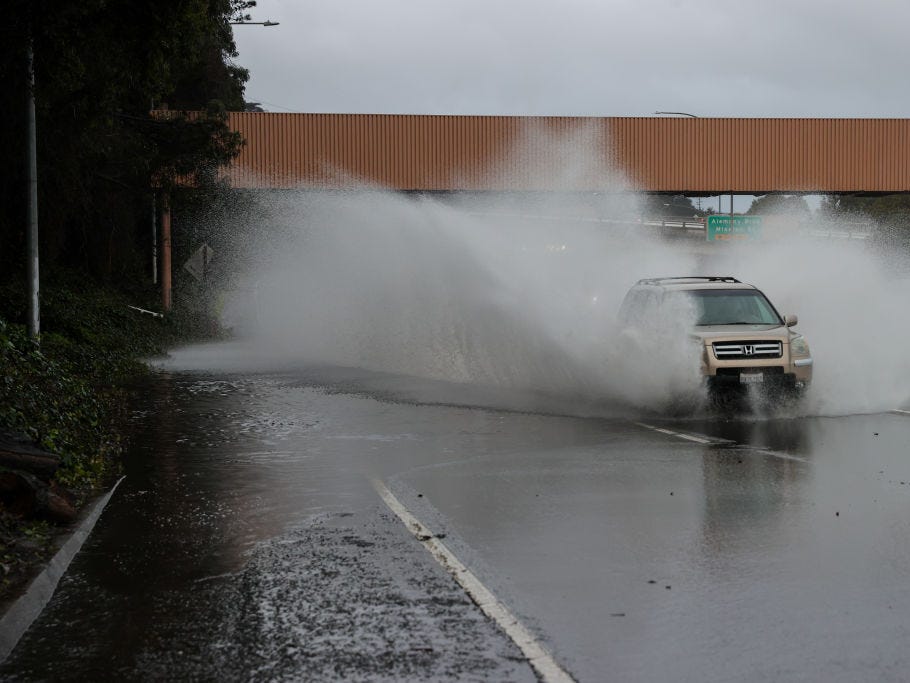Business Insider
The Panjandrum, a rocket-propelled explosive cart, was one of the more curious weapons to have come out of World War II.
British Government/Wikimedia Commons
World War II led to many successful innovations in technology — including weapons.
Some however were considered major flops.
From explosive rats to a 155-foot-long gun, here are some of the most bizarre weapons from WWII.
Unfortunately, war can drive innovation. During World War II, the world’s major powers set their sights on advancing technology, medicine, and communications in order to be efficient and fearsome in battle. Some of the advancements made in WWII were fundamental to modern technology — others, not so much.
Here is a look at some of the most bizarre, useless, and downright insane weapons developed on both sides during WWII.
1. A ship-mounted aerial mine rocket launcher
Crewman on HMS King George V with 7-inch UP Unrotated Projectile antiaircraft projectiles.
Royal Navy via Wikimedia Commons
The unrotated-projectile rocket launcher was an especially ill-conceived antiaircraft measure. Created to protect ships from enemy planes, the unrotated projectile was fired from a ship, and, upon reaching 1,000 feet in elevation, it would explode and disperse mines attached to parachutes via 400 feet of cable.
The general idea was to create an aerial minefield wherein enemy planes would become ensnared in the mess of cables, pulling the mines into their fuselages and downing the plane. However, the mines, cables, and parachutes were all easily visible and enemy pilots had no trouble flying above or below the “aerial minefield”.
Here’s what the weapon looked like when launched:
The unrotated projectile firing and parachuting downward.
Youtube / This Is Genius
The undetonated mines would then be at the mercy of the wind, and they would often float back down toward the British ships that fired them.
“There are no records of UPs bringing down any aircraft. It’s entirely possible that this system injured or killed more Britons than enemies due to accidents, fires, etc,” according to a page dedicated to one of the battle cruisers that carried the weapon.
2. Panjandrum
The Panjandrum, a rocket-propelled explosive cart, was one of the more curious weapons to have come out of World War II.
British Government/Wikimedia Commons
To find a way to breach the German’s concrete defenses in Normandy, the British military devised a large carriage-like contraption called the Panjandrum — a name from a nonsense term coined by an 18th-century British playwright, according to Merriam-Webster.
The device was propelled by rockets attached along the rim of the two wheels. In the middle, a drum would be filled with explosives. According to Wired, the hope was that the Panjandrum could speed toward a concrete wall and blow a hole big enough for a tank to pass through.
But during testing, the device repeatedly lost control and veered off its intended path. In one testing incident, generals had to flee for cover and a cameraman was nearly moved down, according to “Pigeon Guided Missiles: And 49 Other Ideas that Never Took Off,” a book co-authored by James Moore and Paul Nero.
Nikita Karatsupa, the Soviet Union’s most celebrated border guard, and his dog, Ingus, in 1936.
не указаны via Wikimedia Commons
3. Suicide bomb dogs
In 1942, Hitler’s Nazi infantry invaded Soviet Russia with German “Panzer” tanks.
The Russians, who had used military dogs since 1924, sought to turn their canine soldiers into antitank mines by strapping explosives around the dogs’ bodies.
During training, the dogs were starved and let loose on stationary Soviet tanks that had food hidden under them.
Once the dogs were underneath the tank they were trained to pull a detonator cord with their teeth. However, most dogs were unable to comprehend or execute the task while the sights, sounds, and smells of battle raged around them.
The dogs would usually turn around and run toward their Russian handler, only to be shot and killed on sight.
4. Explosive rats
An explosive dummy rat that was sold at a Bonhams auction.
Courtesy Bonhams
Dogs were not the only unfortunate animal victims of experimental war weapons.
The Special Operations Executive branch of the British military also used dead rats that were filled with small explosives, according to Military History. The plan was to infest the German’s coal supply with the rats, which would then detonate once they were unknowingly shoveled into a broiler at a military base or of a steam engine.
The rats were not used as expected because the Germans discovered the device, but, according to The Guardian, they did cause some disruption. Records from the Special Operations Executive branch showed that the German’s discovery of the device prompted a massive search operation for more explosive rats, The Guardian reported.
5. The largest gun ever used in battle
Screen grab
Eager to invade France, Nazi leader Adolf Hitler demanded a new weapon that could easily pierce the concrete fortifications of the French Maginot Line — the only major physical barrier standing between him and the rest of Western Europe.
In 1941, the year after France fell, German steelmaker and arms manufacturer Friedrich Krupp A.G. began constructing Hitler’s Gustav gun, according to the documentary “Top Secret Weapons.”
The four-story, 155-foot-long gun, which weighed 1,350 tons, shot 10,000-pound shells from its mammoth 98-foot barrel.
The gun’s size was not only its source of strength but also its downfall.
The huge gun could only be transported via the rail system and was an easy target for Allied bombers flying overhead. The project was scrapped within a year.
6. Dummy paratroopers
The back of the decoy dummy, “Rupert.”
Courtesy Air Force Museum of New Zealand
As part of the Normandy landings in June 1944, the UK’s Royal Air Force and Britain’s Special Air Service carried out a deception operation to mislead the Germans away from the actual drop zones of Allied troops.
To do so, about 400 stuffed burlap mannequins were released outside the drop zones in Normandy and north of France, according to the Air Force Museum of New Zealand.
These figures, codenamed “Rupert,” were under half a meter tall, contained small explosives to destroy the dummy, and were attached with a noisemaker that mimicked the sound of a firing rile, according to the museum.
Actual British soldiers who were dropped with the dummies were told to allow some German troops to escape so that they could report the sightings of a massive drop of paratroopers.
The operation, codenamed “Titanic,” appeared to be a success as German records revealed that troops were directed to the area of the dummy drop, according to the New Zealand museum.
The US also had its own version of a dummy paratrooper, which can be seen in this declassified video:
7. V-3 cannon
The extremely long German V-3 cannon.
Bundesarchiv, Bild via Wikimedia Commons
The V-3 was the unnecessary younger sibling of the V-1 and V-2 rockets that pulverized London during the Blitzkrieg.
Devised in the summer of 1944, the V-3 was designed to fire 300 nine-foot-long dart-shaped shells every hour. A series of secondary charges positioned along the 416-foot barrel was meant to speed up the projectile, which would hypothetically be able to reach London from well over 100 miles away in the French town of Mimoyecques. But when the V-3 finally became operational, the velocity of the shell was a mere 3,280 feet per second, which was estimated to be about half what was needed to reach London.
Hitler had authorized the production of 50 of these weapons, but before the original plans for the V-3 could be implemented, Allied forces bombed and destroyed the gun, despite Germany’s best efforts to hide the munitions under haystacks.
youtube
In the end, only two miniature (if you can call 150-feet long miniature) versions of the gun became operational, with only a few shots ever fired to an unknown effect.
8. The Krummlauf curved barrel
To solve the conundrum of shooting a rifle while taking cover, the Germans created a curved barrel attachment that would allow soldiers to shoot their weapons around corners.
The device was called Krummlauf and gave a soldier the ability to shoot a weapon from within a tank, according to the Imperial War Museums.
But the attachment turned out to be highly impractical. The bullets often shattered in half before exiting the barrel and the attachment itself became distorted from the immense pressure after a few hundred rounds.
9. A mini “tank-like” remote-controlled demolition vehicle
Wikipedia
The Nazis’ Goliath tracked mine was anything but Goliath-like in stature. Known as the “Doodlebug” by American troops, the Goliath was run with a joystick operated by a controller. It had coiled within its compartments 2,145 feet of cable leading back to the controller. The mini-tank was powered by two electric motors, later replaced by gas burners, and able to carry more than 100 pounds of high explosives.
The Goliath was meant to slide under Allied tanks and deliver its explosive payload to their vulnerable undersides. However, it proved to be susceptible to cord-cutting, and later on, radio-controlled models were introduced. The Germans built 7,500 Goliaths during the war, which suggests that they met with some success.
However, the real success of the Goliath was that it paved the way for radio-controlled weapons, which in our modern age are becoming the new mode of warfare.
10. The “Fugo” balloon bomb
A Japanese balloon flying over North America.
Toronto Star Archives/Toronto Star via Getty Images
In November 1944, Japan released thousands of paper balloon bombs made out of the bark of the mulberry tree.
The balloons were “33 feet in diameter and could lift approximately 1,000 pounds,” according to J. David Rodgers, a Missouri University of Science and Technology professor.
“But the deadly portion of their cargo was a 33-lb anti-personnel fragmentation bomb, attached to a 64-foot long fuse that was intended to burn for 82 minutes before detonating,” he wrote.
The bombs were released into the Pacific jet stream, which would silently carry the large devices from Japan to the US without a pilot. The trip would take several days, NPR reported.
Despite releasing thousands of these devices, the balloon bomb turned out to be ineffective, not to mention resource intensive. It took 30 minutes to an hour to prepare one balloon and required about 30 men to do so, according to the Atomic Heritage Foundation.
During the war, there were only six reported casualties from the balloons, Rodgers wrote — a minister’s wife and five Sunday school students on a fishing trip who encountered one of the balloons near Bly, Oregon. Only a few hundred balloon bombs have been found.
Amanda Macias contributed to this report.










